Captain Fantastic: Elton John’s Discs by the Decade

Photo: David Warner Ellis/Redferns via Getty Images
It started with two young British blokes — each of them half a songwriter — answering an ad in the New Musical Express. One could pen lyrics but couldn’t find a melody. The other worked wonders on the piano but couldn’t string two lines of verse together. But, in 1967, when lyrics written by a young Bernie Taupin were placed into the hands of an equally ambitious pianist named Reg Dwight — who’d later adopt the names of band mates Elton Dean and Long John Baldry to form his own moniker — the next five decades of rock and roll history were forever altered.
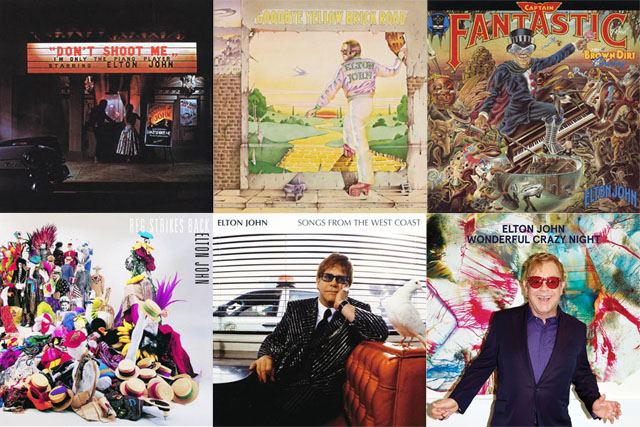
For me personally, Elton John is a revelation. At least that’s how it felt when, as a teenager growing up in the 1990s when grunge and boy bands bookended the musical spectrum, I first listened to one of my parents’ Elton albums. The piano, the lyrics, the costumes, the colour, the rock and roll classics that kept coming with every new second-hand CD I popped into my Discman shaped my understanding of popular music. Though his time as a teenage rock idol had passed decades earlier, for me, whether sitting on a Greyhound bus rolling down the highway or splayed on my bed next to the stereo, the Rocket Man was just taking off. Like countless fans a generation earlier, I was hooked.
To this day, Elton John’s influence on popular music, as well as artists ranging from Axl Rose to Lady Gaga, is indisputable. His upcoming disc — Revamp (April 6) — solidifies this point, with a roster of younger artists reimagining some of Elton and Bernie’s best tunes, including Coldplay (“We All Fall In Love Sometimes”), Mary J. Blige (“Sorry Seems To Be The Hardest Word), Florence +The Machine (“Tiny Dancer”) and Canuck singer-songwriter Alessia Cara (“I Guess That’s Why They Call It The Blues”) among others.
Then, of course, there’s his award-winning theatrical work, tireless philanthropy through the Elton John AIDS Foundation and upcoming three-year Farewell Yellow Brick Road retirement tour.
Now, as Sir Elton celebrates his 72nd birthday on March 25, we’re spotlighting the core of what makes him one of the most pivotal figures in the classic rock lexicon — his studio albums. Join us for a deep dive into Elton’s discography (including some live albums and soundtracks but not greatest hits or other compilations) — from 1969’s Empty Sky to 2016’s Wonderful Crazy Night.
1960s
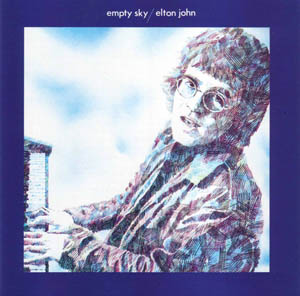
Though re-packaged and released years later in North America, 1969’s Empty Sky served as Elton John and Bernie Taupin’s first foray into the rock music landscape and prefaced their most successful and productive decade to date. With elements of folk, psychedelic and progressive rock, Empty Sky isn’t your typical Elton John disc. It’s more subdued, almost hymn-like, rather than bearing the influence of rock and roll precursors like Jerry Lee Lewis and Chuck Berry. The album’s signature track, “Skyline Pigeon,” which tells of a caged bird “dreaming of the open, waiting for the day, that he can spread his wings and fly away again” is downcast and features only John on the harpsichord — a less memorable rendition than the soulful 1972/73 re-recorded version which features John on piano along with his band. Nevertheless, Elton is on record as noting how excited he was at the time for the single, believing it to be one of the best songs he’d ever heard. He still plays it in concert occasionally, including in the mid-70s at a Royal Festival Hall performance, recorded for the two-disc live album Here and There.
The lack of hit singles on Empty Sky, however, shouldn’t overshadow the fact that the album introduced collaborations that lasted for years and proved pivotal to the singer’s success. Chief among them were Nigel Olssen — who performed on one track on the album, “Lady What’s Tomorrow” — a staple member of the “classic” Elton John Band who still tours with Elton to this day, as well as Gus Dudgeon, who produced some of Elton’s biggest hits including his signature tune, “Your Song.” The same year that he worked on Empty Sky he also produced David Bowie’s “Space Oddity.”
Other future Elton John collaborators who worked on this album include guitarist Caleb Quaye and drummer Roger Pope as well as another longtime producer, Clive Franks.
Interestingly, Elton’s early thoughts on his musical style were that his sound might prove similar to that of Leonard Cohen.
1970s
The six-year period between 1970 and 1976 yielded 10 — yes, 10 — classic Elton John albums and resulted in the bulk of his most famous tunes (Lion King soundtrack notwithstanding).
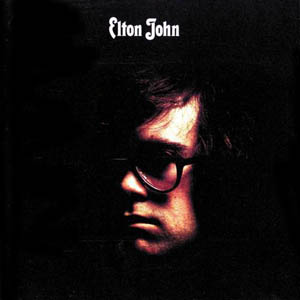
The decade began with 1970’s Elton John, a self-titled sophomore effort (that also served as his debut in America) that earned two Grammy nominations — Album of the Year and Best Male Pop Vocal Performance — while going gold in the United States, peaking at number four on the Billboard charts and number five in the U.K. It’s a disc loaded with great songs that demonstrate Elton’s immense musical versatility in jumping from orchestrated ballads (“Your Song”) to up-tempo rock numbers (“Take Me To the Pilot”) to songs about relationships, birth and death (“I Need You To Turn To,” “The Greatest Discovery” and “Sixty Years On” respectively) to a gospel sound (“Border Song”) and a royal epic (“The King Must Die”) without missing a beat. While “Border Song” was the album’s first single, “Your Song” proved the breakout tune in the era of the singer-songwriter, reaching number eight on the U.S. charts. The disc also brought musical arranger Paul Buckmaster into the Elton John fold, initiating a years-long collaboration between the pair.
Elton followed up that April 1970 disc with the October 1970 release of Tumbleweed Connection, a country infused album that played to Bernie Taupin’s love of American western films and mythology.
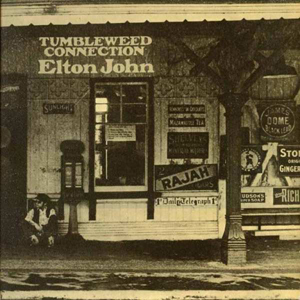
However, English songwriter Lesley Duncan wrote the only single, a quiet ballad called “Love Song.” In hindsight, Tumbleweed Connection and its Americana bent produced a number of well-loved Elton tunes, including “Amoreena,” which was featured in the 1975 Al Pacino film Dog Day Afternoon, “Burn Down the Mission,” “Come Down in Time,” “Country Comfort” and “Where to Now St. Peter?” It also introduced bassist Dee Murray, another staple of the “classic” Elton John Band, and featured backing vocals by Dusty Springfield. The disc went gold, peaking at number five on American charts and number two in the U.K.
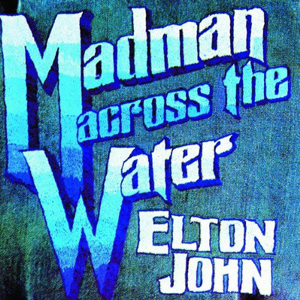 A year later, in November 1971, Madman Across the Water dropped, bringing with it hit singles “Levon” and “Tiny Dancer” — the latter of which achieved fame as a slow burn over years of play, not to mention prominent inclusion in the 2000 film Almost Famous. The former song was reportedly named after The Band’s Levon Helm and the latter dedicated to Maxine Feibelman, Bernie Taupin’s first wife. The title track, originally recorded for Tumbleweed Connection, wasn’t released as a single but has enjoyed success as a live concert tune. The album was eventually certified multi-platinum and introduced guitarist Davey Johnstone, another “classic” band member who still plays with Elton to this day.
A year later, in November 1971, Madman Across the Water dropped, bringing with it hit singles “Levon” and “Tiny Dancer” — the latter of which achieved fame as a slow burn over years of play, not to mention prominent inclusion in the 2000 film Almost Famous. The former song was reportedly named after The Band’s Levon Helm and the latter dedicated to Maxine Feibelman, Bernie Taupin’s first wife. The title track, originally recorded for Tumbleweed Connection, wasn’t released as a single but has enjoyed success as a live concert tune. The album was eventually certified multi-platinum and introduced guitarist Davey Johnstone, another “classic” band member who still plays with Elton to this day.
The year 1971 also included the April release of Elton’s first ever live album, 17-11-70, recorded during a radio performance on New York’s WABC-FM the prior November, featuring original tunes alongside covers of the Beatles’ “Get Back” and the Rolling Stones’ “Honky Tonk Women.” It’s also believed to be the only live recording of an Elton John performance (with a band) without guitarist Davey Johnstone. The disc hit number 11 on the U.S. charts and number 20 in the U.K. but, along with Elton John, Tumbleweed Connection and the soundtrack to the film Friends, penned by John and Taupin, 17-11-70 gave Elton four albums in the Top 100 at one time — matching a record set by the Beatles.
The following year brought the release of Honky Château, the first in a series of seven straight chart-topping discs over the next four years. The album is notable both for the hit songs it produced 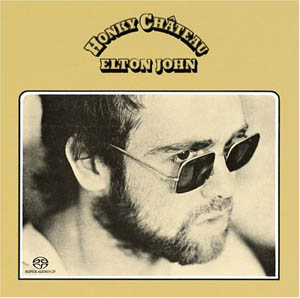 and for the core of musicians who played them. In terms of music, “Rocket Man,” arguably Elton’s second signature tune behind “Your Song,” leads the pack followed by “Honky Cat,” “Mona Lisas and Mad Hatters” and the tap-dancing teenage drama “I Think I’m Going to Kill Myself,” all of which spotlight Elton’s innate rock and roll instincts for the first time on a studio disc. Honky Château also features the debut of the “classic” Elton John Band core of Elton on piano and vocals, Davey Johnstone on guitar, Dee Murray on bass and Nigel Olssen on drums, not to mention the debut of longtime Elton percussionist Ray Cooper.
and for the core of musicians who played them. In terms of music, “Rocket Man,” arguably Elton’s second signature tune behind “Your Song,” leads the pack followed by “Honky Cat,” “Mona Lisas and Mad Hatters” and the tap-dancing teenage drama “I Think I’m Going to Kill Myself,” all of which spotlight Elton’s innate rock and roll instincts for the first time on a studio disc. Honky Château also features the debut of the “classic” Elton John Band core of Elton on piano and vocals, Davey Johnstone on guitar, Dee Murray on bass and Nigel Olssen on drums, not to mention the debut of longtime Elton percussionist Ray Cooper.
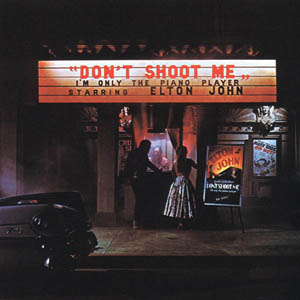 Don’t Shoot Me I’m Only the Piano Player rocketed up the charts upon release in January 1973 on the back of hit singles “Crocodile Rock” and “Daniel” — two staples of Elton’s Greatest Hits catalogue and concerts to this day. But beyond that the album also spotlights Elton’s versatility as a singer through tunes like the soulful “Blues for My Baby and Me,” the desperate “Have Mercy on the Criminal,” and songs inspired by rockers Marc Bolan, Van Morrison and the Rolling Stones: “I’m Gonna Be a Teenage Idol,” “High Flying Bird” and “Midnight Creeper” respectively. The album also features a striking cover illustration of an old theatre marquee announcing “Don’t Shoot Me I’m Only the Piano Player by Elton John.” David Buckley’s Elton The Biography claims the album’s title comes from John’s retort after finding himself on the end of a series of verbal barbs from Groucho Marx. A poster for the Marx Brother’s film Go West is included on the album’s cover.
Don’t Shoot Me I’m Only the Piano Player rocketed up the charts upon release in January 1973 on the back of hit singles “Crocodile Rock” and “Daniel” — two staples of Elton’s Greatest Hits catalogue and concerts to this day. But beyond that the album also spotlights Elton’s versatility as a singer through tunes like the soulful “Blues for My Baby and Me,” the desperate “Have Mercy on the Criminal,” and songs inspired by rockers Marc Bolan, Van Morrison and the Rolling Stones: “I’m Gonna Be a Teenage Idol,” “High Flying Bird” and “Midnight Creeper” respectively. The album also features a striking cover illustration of an old theatre marquee announcing “Don’t Shoot Me I’m Only the Piano Player by Elton John.” David Buckley’s Elton The Biography claims the album’s title comes from John’s retort after finding himself on the end of a series of verbal barbs from Groucho Marx. A poster for the Marx Brother’s film Go West is included on the album’s cover.
As if Don’t Shoot Me I’m Only the Piano Player wasn’t enough of a hit to sustain Elton for the year, he released Goodbye Yellow Brick Road in October of 1973, considered by many as the greatest Elton John disc as well as his debut as a glam rock star. It’s also the highest charting of the six Elton 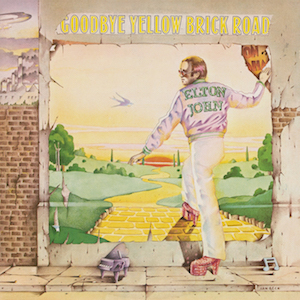 offerings that appear on Rolling Stone’s list of “500 Greatest Albums of All Time,” landing at number 91. The mag called Elton, at this point in his career, “the most consistent hitmaker since the Fab Four” and noted, “Everything about Goodbye Yellow Brick Road is supersonically huge, from the Wagnerian-opera like combo of ‘Funeral for a Friend’ and ‘Love Lies Bleeding” to the electric boots and mohair suit of ‘Bennie and the Jets.’ ‘Saturday Night’s Alright for Fighting’ is strutting rock & roll, ‘Candle in the Wind’ pays tribute to Marilyn Monroe, and the title track harnesses the fantastic imagery of glam to a Gershwin-sweet melody.”
offerings that appear on Rolling Stone’s list of “500 Greatest Albums of All Time,” landing at number 91. The mag called Elton, at this point in his career, “the most consistent hitmaker since the Fab Four” and noted, “Everything about Goodbye Yellow Brick Road is supersonically huge, from the Wagnerian-opera like combo of ‘Funeral for a Friend’ and ‘Love Lies Bleeding” to the electric boots and mohair suit of ‘Bennie and the Jets.’ ‘Saturday Night’s Alright for Fighting’ is strutting rock & roll, ‘Candle in the Wind’ pays tribute to Marilyn Monroe, and the title track harnesses the fantastic imagery of glam to a Gershwin-sweet melody.”
This double-album also doubles down on non-hit tunes that pack a musical punch, including the western-inspired “The Ballad of Danny Bailey (1909–34),” the tragic “All the Girls Love Alice,” the all-in “Your Sister Can’t Twist (But She Can Rock ‘n Roll),” the nostalgic “Roy Rogers” and the final haunting track, “Harmony.” It’s no wonder this album is Elton’s biggest selling, hitting the platinum mark eight times over and earning an induction into the Grammy Hall of Fame. As well, like its predecessor, it boasts some of the most beautiful album art of Elton’s discography.
In contrast, the 1974 album Caribou features garish cover art and fewer memorable tunes, though it produced the hits “Don’t Let the Sun Go Down on Me” and “The Bitch is Back,” making it the fourth straight Elton album to top the charts while earning a Grammy nomination in the process. Another notable tune from the album is “You’re So Static,” which Elton performed on his Here and There live album.
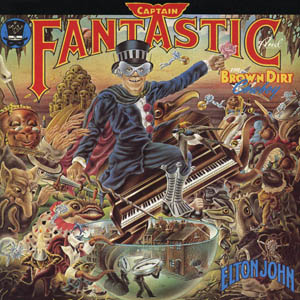 By May, 1975 the brilliant album art returned with the autobiographical masterpiece (and my personal favourite Elton album) Captain Fantastic and the Brown Dirt Cowboy. In essence, Captain Fantastic is Elton and the Brown Dirt Cowboy is Bernie Taupin and the songs on the disc document the pair’s rise from humble songwriters to their career breakthrough, including Elton’s engagement and subsequent suicide attempt — the subject of the disc’s only single “Someone Saved My Life Tonight.” The album, while the least commercial of Elton’s career, is, to me, a perfect encapsulation of the best of the Elton/Bernie partnership — unapologetically raw, introspective lyrics coupled with pitch-perfect composition that offers a cross-section of Elton’s talents, from soft/mournful ballads to rocking tunes to nostalgic kicks. The album went multi-times platinum and, following the temporary departure of bassist Dee Murray and drummer Nigel Olssen after this disc, proved the final time Elton, Davey Johnstone, Murray and Olssen would record together for eight years. Fans of this album definitely need to check out a live version Elton performed with his band in England around the time of its release in 1975. Available on iTunes, it’s a high-energy concert featuring Elton and Co. in their prime adding a distinctly edgier sound to these tunes. And in 2006, Elton and Bernie followed this album up with an autobiographical sequel, The Captain and the Kid, which picks up where this disc leaves off.
By May, 1975 the brilliant album art returned with the autobiographical masterpiece (and my personal favourite Elton album) Captain Fantastic and the Brown Dirt Cowboy. In essence, Captain Fantastic is Elton and the Brown Dirt Cowboy is Bernie Taupin and the songs on the disc document the pair’s rise from humble songwriters to their career breakthrough, including Elton’s engagement and subsequent suicide attempt — the subject of the disc’s only single “Someone Saved My Life Tonight.” The album, while the least commercial of Elton’s career, is, to me, a perfect encapsulation of the best of the Elton/Bernie partnership — unapologetically raw, introspective lyrics coupled with pitch-perfect composition that offers a cross-section of Elton’s talents, from soft/mournful ballads to rocking tunes to nostalgic kicks. The album went multi-times platinum and, following the temporary departure of bassist Dee Murray and drummer Nigel Olssen after this disc, proved the final time Elton, Davey Johnstone, Murray and Olssen would record together for eight years. Fans of this album definitely need to check out a live version Elton performed with his band in England around the time of its release in 1975. Available on iTunes, it’s a high-energy concert featuring Elton and Co. in their prime adding a distinctly edgier sound to these tunes. And in 2006, Elton and Bernie followed this album up with an autobiographical sequel, The Captain and the Kid, which picks up where this disc leaves off.
In October, 1975, Elton released Rock of the Westies which, like Captain Fantastic, debuted at number one — the first time an artist ever had two consecutive albums debut atop the charts. The album’s main singles, “Island Girl” and “Grow Some Funk of Your Own” proved hits but, unlike most of Elton’s albums during this period, it failed to offer a tune that would be considered an Elton classic. However, a roster of rocking tracks like “Medley (Yell Help/Wednesday Night/Ugly),” “Dan Dare (Pilot of the Future),” “Hard Luck Story” and “Billy Bones and the White Bird” and the B-side ballad “I Feel Like a Bullet (In the Gun of Robert Ford)” more than make this a solid Elton offering.
Blue Moves followed a year later, in October 1976, and proved the final in a string of seven straight chart-topping studio albums. It’s another double album though not remotely as highly regarded 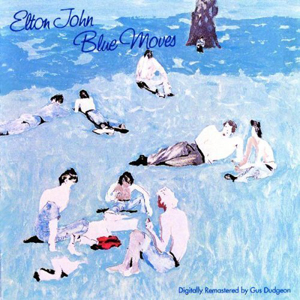 as Elton’s previous one, Goodbye Yellow Brick Road. In fact, Blue Moves was largely panned. The album is like watching a three-hour movie that should have been cut down to one-and-a-half, with multiple instrumental tracks seemingly employed to stretch this out to a double-disc length. Most of the first side of the album, aside from “Tonight” and “Cage the Songbird,” could have been cut, while the second side, though still marked with filler, contained the hit “Sorry Seems to Be the Hardest Word” as well as solid tunes like “Between Seventeen and Twenty,” “The Wide-Eyed and Laughing,” “Someone’s Final Song,” “Where’s the Shoorah?” and “Idol.” Overall, though, between the musical interludes and mournful nature of many of the songs, it’s easy to see why this album isn’t held in the same regard as others from this “classic” period.
as Elton’s previous one, Goodbye Yellow Brick Road. In fact, Blue Moves was largely panned. The album is like watching a three-hour movie that should have been cut down to one-and-a-half, with multiple instrumental tracks seemingly employed to stretch this out to a double-disc length. Most of the first side of the album, aside from “Tonight” and “Cage the Songbird,” could have been cut, while the second side, though still marked with filler, contained the hit “Sorry Seems to Be the Hardest Word” as well as solid tunes like “Between Seventeen and Twenty,” “The Wide-Eyed and Laughing,” “Someone’s Final Song,” “Where’s the Shoorah?” and “Idol.” Overall, though, between the musical interludes and mournful nature of many of the songs, it’s easy to see why this album isn’t held in the same regard as others from this “classic” period.
Aside from Blue Moves, another Elton double album debuted in 1976 — Here and There. The first disc contained a recording of a 1974 performance at Royal Festival Hall and the second Elton’s Thanksgiving 1974 performance at Madison Square Garden. The original LP and CD releases include a mere five tracks from the former concert and four tracks from the latter, and it’s only on the mid-1990s rerelease that a solid selection of each set is heard. Most notably, John Lennon makes an historic appearance on the Madison Square Garden show, battling stage fright to perform his single “Whatever Gets You Thru the Night,” Elton’s new single, a cover of “Lucy in the Sky with Diamonds” and the Beatles hit “I Saw Her Standing There.” The Lennon appearance came about as the result of a bet that Elton and Lennon had made. Elton, who appeared on the Lennon single “Whatever Gets You thru the Night,” bet the former Beatle, who’d appeared on Elton’s “Lucy in the Sky with Diamonds” single, that the Lennon song would top the charts. Lennon didn’t think it would and agreed that, if it did, he’d appear live in concert with Elton. The Lennon tune topped the charts and Elton cashed in on the bet, bringing Lennon on for three tunes. What makes this an historic appearance? Well, this is John Lennon’s last ever live performance before his assassination in 1980.
By 1978, Elton experienced a musical shakeup. The core of his classic band was gone, with Davey Johnstone appearing on only one track of the album A Single Man. Even more importantly, the album is the first of Elton’s career without lyrics by Bernie Taupin (Gus Osborne took over) or Gus Dudgeon producing. The result was a gold record with a string of bronze-level tunes, the most notable among them being “Part-Time Love” and “Song for Guy.” Elton also abandoned his trademark high singing voice/falsetto for the album, singing with a lower voice at the urging of noted soul music producer Thom Bell (who recorded with Elton a series of songs that would be released later as the Thom Bell Sessions). The 1979 disc Victim of Love, still devoid of Bernie Taupin and now totally missing Davey Johnstone, is a disco-themed collection of tunes and covers, including Chuck Berry’s “Johnny B. Goode.” The single “Victim of Love” enjoyed some chart success but overall there’s really nothing from this disc that proved memorable in the context of Elton’s career. It did, however, offer something of an omen for the artistic and commercial struggles Elton would face in the next decade.
1980s
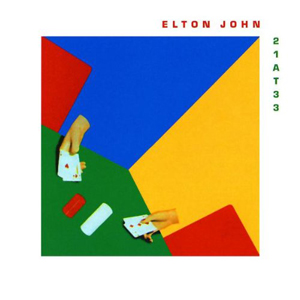 The 1980s were a strange time for Elton’s music, a hit-and-miss decade peppered with the occasional hit single. It began in 1980 with 21 at 33 (Elton’s 21st album — counting all greatest hits discs, soundtracks and other releases until that point — and his age at the time), which reunited the singer with lyricist Bernie Taupin after a two-year hiatus. Others still claim songwriting credits on the disc too though, including Gary Osborne and singer-songwriters Tom Robinson and Judie Tzuke. The disc also brought Dee Murray and Nigel Olssen back into the fold and featured string arrangements by David Foster and backing vocals from Don Henley, Glenn Frey and other guests. The album almost reached the one million mark in sales and its one hit single, “Little Jeannie,” topped the adult contemporary charts in North America. The following year brought The Fox — a rare Elton release that performed poorly both financially and artistically, failing to produce even one song that music lovers beyond the hardest of hardcore Elton fans would know. It did, however, provide the debut of longtime Elton producer Chris Thomas and the tune “Elton’s Song,” about a teen boy’s homosexual feelings, which proved somewhat controversial at the time. Jump Up!, released in 1982, didn’t hold up much better, with even Bernie Taupin calling it, “a terrible, awful, disposable album, but it had ‘Empty Garden’ on it, so it’s worth it for that one song.” Actually, along with “Empty Garden (Hey Hey Johnny),” written as a tribute to John Lennon following his assassination in 1980, the album also contains another favourite in “Blue Eyes.” The disc was still certified gold in America and also serves as the answer to the trivia question, “Long before The Lion King, Aida or The Road to El Dorado, what was the first collaboration between Elton John and lyricist Tim Rice?” The answer is the song “Legal Boys” on this album. Also, The Who’s Pete Townshend played guitar on the tune “Ball and Chain.”
The 1980s were a strange time for Elton’s music, a hit-and-miss decade peppered with the occasional hit single. It began in 1980 with 21 at 33 (Elton’s 21st album — counting all greatest hits discs, soundtracks and other releases until that point — and his age at the time), which reunited the singer with lyricist Bernie Taupin after a two-year hiatus. Others still claim songwriting credits on the disc too though, including Gary Osborne and singer-songwriters Tom Robinson and Judie Tzuke. The disc also brought Dee Murray and Nigel Olssen back into the fold and featured string arrangements by David Foster and backing vocals from Don Henley, Glenn Frey and other guests. The album almost reached the one million mark in sales and its one hit single, “Little Jeannie,” topped the adult contemporary charts in North America. The following year brought The Fox — a rare Elton release that performed poorly both financially and artistically, failing to produce even one song that music lovers beyond the hardest of hardcore Elton fans would know. It did, however, provide the debut of longtime Elton producer Chris Thomas and the tune “Elton’s Song,” about a teen boy’s homosexual feelings, which proved somewhat controversial at the time. Jump Up!, released in 1982, didn’t hold up much better, with even Bernie Taupin calling it, “a terrible, awful, disposable album, but it had ‘Empty Garden’ on it, so it’s worth it for that one song.” Actually, along with “Empty Garden (Hey Hey Johnny),” written as a tribute to John Lennon following his assassination in 1980, the album also contains another favourite in “Blue Eyes.” The disc was still certified gold in America and also serves as the answer to the trivia question, “Long before The Lion King, Aida or The Road to El Dorado, what was the first collaboration between Elton John and lyricist Tim Rice?” The answer is the song “Legal Boys” on this album. Also, The Who’s Pete Townshend played guitar on the tune “Ball and Chain.”
Too Low For Zero, released in 1983, proved a breath of fresh air, with Bernie Taupin penning all the lyrics and Davey Johnstone returning to the band. The album became Elton’s biggest release of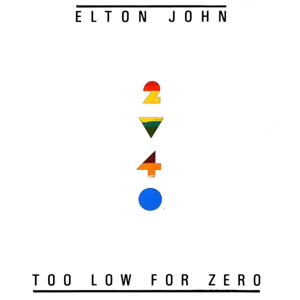 the decade, both commercially (it went platinum) and artistically, yielding hits like “I Guess That’s Why They Call It the Blues,” “I’m Still Standing,” “Kiss the Bride,” and “Too Low for Zero.” It’s not quite classic Elton, as there’s still a lot of synthesizer and other traces of 1980s instrumental tastes scattered throughout, but it’s as close as Elton got in years to reclaiming the hit-making magic of the previous decade.
the decade, both commercially (it went platinum) and artistically, yielding hits like “I Guess That’s Why They Call It the Blues,” “I’m Still Standing,” “Kiss the Bride,” and “Too Low for Zero.” It’s not quite classic Elton, as there’s still a lot of synthesizer and other traces of 1980s instrumental tastes scattered throughout, but it’s as close as Elton got in years to reclaiming the hit-making magic of the previous decade.
Breaking Hearts followed in 1984, featuring only Elton, Davey Johnstone, Dee Murray and Nigel Olssen (except for the saxophone on one song). It went gold with the support of “Sad Songs (Say So Much),” an Elton staple, and “Passengers,” a hit across the pond. Ice on Fire, in 1985, marked the departure of drummer Nigel Olssen but the return of producer Gus Dudgeon. Hits like “Nikita” and “Wrap Her Up,” both featuring George Michael on backing vocals, stand out but overall the album underperformed except in the United Kingdom, where it peaked at number three on the charts. Meanwhile, Leather Jackets holds the dubious distinction of being the only Elton album since 1970 to fail to produce a Top 40 hit on either side of the pond. The main single was “Heartache All Over the World” but many, including Elton, consider the album as among the worst of his discs.
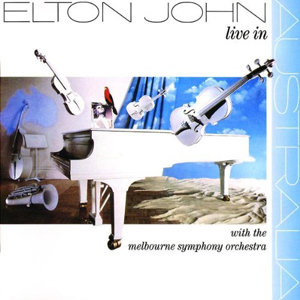 Mercifully, 1987 brought Live in Australia with the Melbourne Symphony Orchestra, which may be the most unique live Elton recording ever. Recorded a year earlier, just months before Elton underwent throat surgery, it features early tunes like “Sixty Years On” and “The Greatest Discovery” mixed with favourites like “Your Song,” “Candle in the Wind” and “Tiny Dancer.” All the elements of this performance come together in perfect harmony, so to speak, from the power and grittiness of Elton’s voice to the impeccable piano sound to the orchestra and backing vocals. Elton’s emotional takes on tunes like “The King Must Die” and “Have Mercy on the Criminal” are outstanding and his heartfelt version of “Your Song” remains my favourite version of the tune ever recorded. Seriously, if you have never heard this album, seek it out. It’s proof that, no matter what level of success he achieved with any given album release, Elton has always been a rock solid live performer throughout every phase of his career.
Mercifully, 1987 brought Live in Australia with the Melbourne Symphony Orchestra, which may be the most unique live Elton recording ever. Recorded a year earlier, just months before Elton underwent throat surgery, it features early tunes like “Sixty Years On” and “The Greatest Discovery” mixed with favourites like “Your Song,” “Candle in the Wind” and “Tiny Dancer.” All the elements of this performance come together in perfect harmony, so to speak, from the power and grittiness of Elton’s voice to the impeccable piano sound to the orchestra and backing vocals. Elton’s emotional takes on tunes like “The King Must Die” and “Have Mercy on the Criminal” are outstanding and his heartfelt version of “Your Song” remains my favourite version of the tune ever recorded. Seriously, if you have never heard this album, seek it out. It’s proof that, no matter what level of success he achieved with any given album release, Elton has always been a rock solid live performer throughout every phase of his career.
Reg Strikes Back in 1988 proved a reinvention of sorts for Elton. His first album after throat surgery the previous year, it takes its name in part from 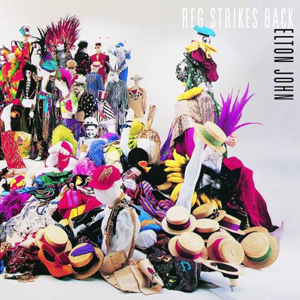 the singer’s given name (Reginald Kenneth Dwight) and the cover features a collection of the wacky stage costumes he’s worn over the years – from floppy feathers to Donald Duck — while a black and white photo of Elton as a boy peeks out from the pile. Gone are the half-hearted tunes that render some of his previous 80s offerings more or less forgettable — Reg Strikes Back, in my opinion, boasts some of the strongest songs Elton produced that decade. It reached gold status on the back of four singles — “I Don’t Wanna Go On with You Like That,” “Town of Plenty” (featuring Pete Townshend on guitar), “A Word in Spanish” and “Mona Lisas and Mad Hatters, Part Two” — which, along with tunes like “Japanese Hands,” “Goodbye Marlon Brando” and “Since God Invented Girls,” showcase Elton’s musical range and seemingly re-invigorated spirit. If there’s a downside it’s that this is the last Elton album Dee Murray — a core band member — played on before passing away following a stroke in 1992 at age 45.
the singer’s given name (Reginald Kenneth Dwight) and the cover features a collection of the wacky stage costumes he’s worn over the years – from floppy feathers to Donald Duck — while a black and white photo of Elton as a boy peeks out from the pile. Gone are the half-hearted tunes that render some of his previous 80s offerings more or less forgettable — Reg Strikes Back, in my opinion, boasts some of the strongest songs Elton produced that decade. It reached gold status on the back of four singles — “I Don’t Wanna Go On with You Like That,” “Town of Plenty” (featuring Pete Townshend on guitar), “A Word in Spanish” and “Mona Lisas and Mad Hatters, Part Two” — which, along with tunes like “Japanese Hands,” “Goodbye Marlon Brando” and “Since God Invented Girls,” showcase Elton’s musical range and seemingly re-invigorated spirit. If there’s a downside it’s that this is the last Elton album Dee Murray — a core band member — played on before passing away following a stroke in 1992 at age 45.
Elton closed out the decade with a tribute to his longtime writing partner Bernie Taupin with 1989’s Sleeping with the Past. A chart-topping disc in the U.K. and certified platinum in the U.S., this album, inspired by, and infused with, the R&B music Elton and Bernie grew up with features a solid lineup including “Durban Deep,” “Healing Hands,” “Club at the End of the Street,” “Sleeping with the Past,” “I Never Knew Her Name” and “Amazes Me” as well as Elton’s first ever U.K. chart-topping single, “Sacrifice.” Longtime Elton keyboardist Guy Babylon debuted on this album and it also served as the first entirely solo Elton/Bernie writing collaboration in 14 years. Though it’s taken time to truly earn appreciation from some, Sleeping with the Past really was a solid finale to a less than steady decade.
1990s
Elton sought help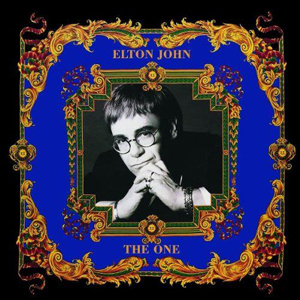 for drug and alcohol addiction as well as an eating disorder in the early 1990s, which in part led to the three-year delay between Sleeping with the Past and the 1992 disc The One. With feet firmly planted in highly orchestrated adult contemporary love ballad territory, Elton delivered a multi-platinum effort stacked with earworms, from the chart-topping title track to “Simple Life,” “Runaway Train” (which features Eric Clapton), “Whitewash County,” “When a Woman Doesn’t Want You,” “Emily,” “Understanding Women” (featuring David Gilmour) and “The Last Song,” a tear-inducing tribute written after the passing of Freddie Mercury from AIDS and the Elton John AIDS Foundation’s inaugural charity single. Make no mistake, this album is the opposite of the stripped down sound of Elton’s 1970s piano/guitar/bass/drum rock and folk style. If the grittier, more organic Goodbye Yellow Brick Road was aimed at the rocking teenage crowd, The One sought out that same crowd’s parents with its polished tunes and dramatic production that, at points, plays like the soundtrack for an epic romance novel. It’s a great album but far closer to the spirit of “Can You Feel the Love Tonight” than “Captain Fantastic.” That’s not a bad thing — it just depends how many layers of keyboards and how fierce a “whooshing” sound of wind you like on top of your rock and roll. For Elton at that point in his life and career, it was a solid album and, personally, it holds a special place in my heart as it was the first Elton album I ever heard.
for drug and alcohol addiction as well as an eating disorder in the early 1990s, which in part led to the three-year delay between Sleeping with the Past and the 1992 disc The One. With feet firmly planted in highly orchestrated adult contemporary love ballad territory, Elton delivered a multi-platinum effort stacked with earworms, from the chart-topping title track to “Simple Life,” “Runaway Train” (which features Eric Clapton), “Whitewash County,” “When a Woman Doesn’t Want You,” “Emily,” “Understanding Women” (featuring David Gilmour) and “The Last Song,” a tear-inducing tribute written after the passing of Freddie Mercury from AIDS and the Elton John AIDS Foundation’s inaugural charity single. Make no mistake, this album is the opposite of the stripped down sound of Elton’s 1970s piano/guitar/bass/drum rock and folk style. If the grittier, more organic Goodbye Yellow Brick Road was aimed at the rocking teenage crowd, The One sought out that same crowd’s parents with its polished tunes and dramatic production that, at points, plays like the soundtrack for an epic romance novel. It’s a great album but far closer to the spirit of “Can You Feel the Love Tonight” than “Captain Fantastic.” That’s not a bad thing — it just depends how many layers of keyboards and how fierce a “whooshing” sound of wind you like on top of your rock and roll. For Elton at that point in his life and career, it was a solid album and, personally, it holds a special place in my heart as it was the first Elton album I ever heard.
In 1993, the album Duets debuted and eventually went platinum in America. The disc features Elton performing duets of his own and other peoples’ songs with fellow music superstars from Little Richard to Leonard Cohen to Gladys Knight, Don Henley and Bonnie Raitt. The chart-topping live duet of “Don’t Let the Sun Go Down on Me” with George Michael is included, as is another hit, “True Love,” with Kiki Dee.
The next year, however, brought Elton’s most monumental release of the decade, The Lion King. We all know how this story goes — a monster soundtrack to a monster Disney film that wins tons of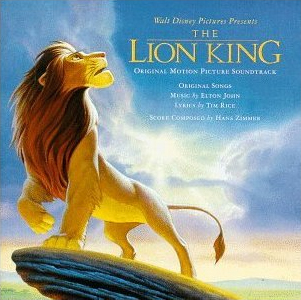 awards including nabbing Elton an Oscar for Best Original Song for “Can You Feel the Love Tonight” (he was nominated three times in that same category, for “Circle of Life” and “Hakuna Matata” as well) and a Grammy for Best Male Pop Vocal Performance for the same tune while eventually launching a monster Broadway musical. The 15 million copies that the Lion King soundtrack sold certified it diamond, while the wide-reaching success of the collaboration between Elton and lyricist Tim Rice on this project remains virtually unparalleled to this day.
awards including nabbing Elton an Oscar for Best Original Song for “Can You Feel the Love Tonight” (he was nominated three times in that same category, for “Circle of Life” and “Hakuna Matata” as well) and a Grammy for Best Male Pop Vocal Performance for the same tune while eventually launching a monster Broadway musical. The 15 million copies that the Lion King soundtrack sold certified it diamond, while the wide-reaching success of the collaboration between Elton and lyricist Tim Rice on this project remains virtually unparalleled to this day.
Elton found his way into the Rock and Roll Hall of Fame in 1994 and, in 1995, released Made In England. It hit the platinum target in the U.S. and the single “Believe” earned Elton a Grammy nomination for Best Pop Vocal Performance, while Sir George Martin helped arrange the strings and French horn on the song “Latitude.” The songs did well in Canada and other countries but “Believe” was the only one with any real traction in America and, despite its commercial success, it’s not remembered as one of Elton’s finest offerings.
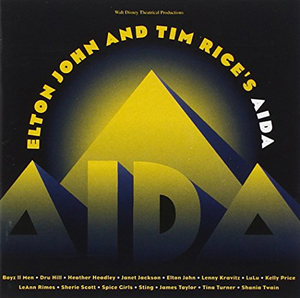 In 1997 The Big Picture, dedicated to Elton’s slain friend, designer Gianni Versace, nabbed the number nine spot on the Billboard charts but the album, which boasted the single “Something About the Way You Look Tonight” and the Luciano Pavarotti duet “Live Like Horses,” remains probably the least revered Elton album of the 1990s. That same year, though, he also released what would become the best-selling single of all time — “Candle in the Wind 1997” — a tribute to another of his dear friends who died too soon, Princess Diana.
In 1997 The Big Picture, dedicated to Elton’s slain friend, designer Gianni Versace, nabbed the number nine spot on the Billboard charts but the album, which boasted the single “Something About the Way You Look Tonight” and the Luciano Pavarotti duet “Live Like Horses,” remains probably the least revered Elton album of the 1990s. That same year, though, he also released what would become the best-selling single of all time — “Candle in the Wind 1997” — a tribute to another of his dear friends who died too soon, Princess Diana.
Two years later, Elton and Tim Rice attempted to replicate their Lion King success with the release of the musical soundtrack/concept album Elton John and Tim Rice’s Aida. The actual Broadway musical came a year after this album laid the groundwork, featuring a slew of huge musical guests including Janet Jackson, Sting, Tina Turner, James Taylor, Shania Twain, Lenny Kravitz, and Boyz II Men among others. Both the album and the single, “Written in the Stars,” an Elton duet with LeAnn Rimes, earned gold certification. Elton also composed the music and sang on the soundtrack for the Albert Brooks film The Muse that same year, though few remember either the film or the music.
2000s
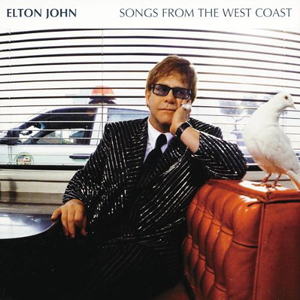 Elton and Tim Rice kicked off the new millennium by collaborating on another animated film soundtrack — Dreamworks’ The Road to El Dorado. Though the film was mostly panned the soundtrack is remarkably strong and, in my opinion, highly underrated. But by 2001 and the release of Songs From the West Coast, El Dorado proved a distant memory.
Elton and Tim Rice kicked off the new millennium by collaborating on another animated film soundtrack — Dreamworks’ The Road to El Dorado. Though the film was mostly panned the soundtrack is remarkably strong and, in my opinion, highly underrated. But by 2001 and the release of Songs From the West Coast, El Dorado proved a distant memory.
Songs From the West Coast dropped like a revelation – this, essentially, is what the Elton John of Tumbleweed Connection through Blue Moves would sound like three decades on. Stripped down to the bare musical essentials, with a raw rock and bass-infused blues vibe that runs through it, Songs from the West Coast tore away most of the adult contemporary walls Elton had built and allowed him to seemingly bare his soul on analog, from pared-down singles like “I Want Love” to “Dark Diamond” (featuring Stevie Wonder) to the tribute to Matthew Shepard, a young gay man murdered in 1998, “Original Sin.” The mournful “Ballad of the Boy in the Red Shoes” recounts the ignorance surrounding the AIDS epidemic in the 1980s while “This Train Don’t Stop There Anymore” is a laid-bare confession of a one-time rock sensation facing down the twilight of his life. It’s not an exact return to 1970s form but this album did away with the overproduction and allowed Elton to sit at the piano and play his heart out with little excess noise to hamper him.
The 2004 disc Peachtree Road continued in that stripped down spirit but added an element of the American south to the musical vibe — a nod, like the title of the disc, to the state of Georgia, where Elton owns a home. The album has its moments, like the tune “Porch Swing in Tupelo,” which references Elvis Presley, but despite earning gold status it’s one of Elton’s less popular discs of the past decade. By 2005 though Elton took his sights from Peachtree Road to London’s West End with the massively successful musical Billy Elliot, for which Elton wrote the tunes and landed scores of subsequent awards and accolades.
And then, in 2006, the autobiographical The Captain and the Kid, Elton and Bernie’s sequel to 1975’s Captain Fantastic and the Brown Dirt Cowboy, debuted and hit the top 10 on U.K charts and top 20 in the U.S. It’s similar in many ways to The Road to El Dorado in that it’s got a lineup of mostly solid songs but due to a lack of promotion and discernable hit singles it isn’t remembered as fondly as other albums. This, however, really is a respectable follow up to Captain Fantastic and the Brown Dirt Cowboy, and contains songs like “Postcards from Richard Nixon,” “Just Like Noah’s Ark,” “I Must Have Lost It on the Wind” and “The Captain and the Kid” — some of the best Elton tunes this side of Songs from the West Coast.
2010s
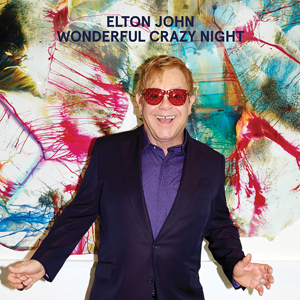 Elton fulfilled a lifelong dream by teaming with one of his musical idols, Leon Russell, for 2010’s The Union — an album that proved both a critical and commercial hit, entering the charts in the third spot and garnering a Grammy nomination for the Best Pop Collaboration for “If It Wasn’t for Bad.” Songs like “Eight Hundred Dollar Shoes,” “Hey Ahab,” “The Best Part of the Day,” “I Should Have Sent Roses” and “When Love Is Dying” highlight this vocal pairing that, on the surface, seems ill-fitted but ultimately serves to accentuate the strengths of both legendary artists.
Elton fulfilled a lifelong dream by teaming with one of his musical idols, Leon Russell, for 2010’s The Union — an album that proved both a critical and commercial hit, entering the charts in the third spot and garnering a Grammy nomination for the Best Pop Collaboration for “If It Wasn’t for Bad.” Songs like “Eight Hundred Dollar Shoes,” “Hey Ahab,” “The Best Part of the Day,” “I Should Have Sent Roses” and “When Love Is Dying” highlight this vocal pairing that, on the surface, seems ill-fitted but ultimately serves to accentuate the strengths of both legendary artists.
In 2011 Elton featured on Gnomeo & Juliet: Original Soundtrack, singing a slew of his most famous songs including duets with artists like Nelly Furtado (“Crocodile Rock”). By 2013, Elton returned with an album of original tunes, The Diving Board which, like The Union, doesn’t include any of his original band members. The disc debuted in the top five on the charts on both sides of the pond and is an even more complete collection of solid, raw tunes than Songs from the West Coast, including “Oscar Wilde Gets Out,” “A Town Called Jubilee,” “The Ballad of Blind Tom,” “Can’t Stay Alone Tonight,” “Home Again,” “The New Fever Waltz,” “Mexican Vacation (Kids in the Candlelight)” and the title track.
And last year, Elton dropped the decidedly upbeat and cheery disc Wonderful Crazy Night, reuniting the remaining members of his classic band and providing another hit disc. Admittedly, the album took me some time to warm up to but I eventually came around to appreciate some fantastic musical hooks, impossible earworms and strong lyrics from Bernie.
Now, with Elton’s 70th birthday upon us and his desire to spend more time with his two young sons, new music could become less and less of a priority. And we can’t blame him. But after nearly 50 years of music we’re grateful for the trove of rock treasures and (not so) secretly hope that Captain Fantastic and the Brown Dirt Cowboy haven’t hung up their piano and pens for good.
RELATED:
Elton John on Diana, Paul McCartney and Other Celebrity Encounters in His New Memoir ‘Me’
From Sequins to San Francisco: 5 Fantastic Elton John Live Performances